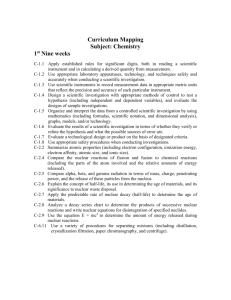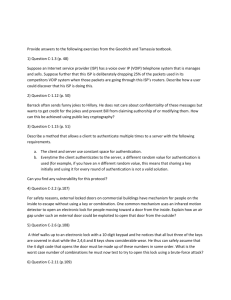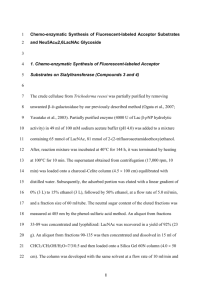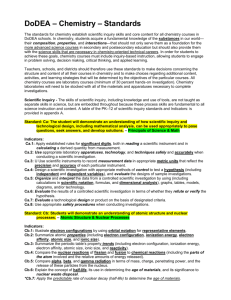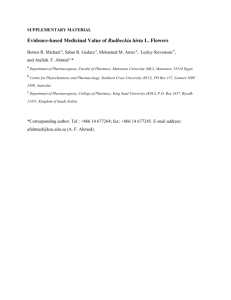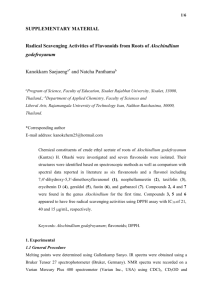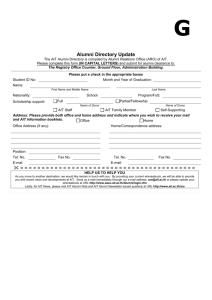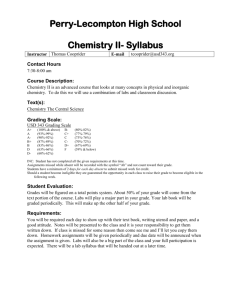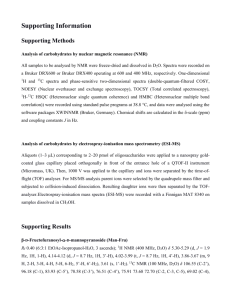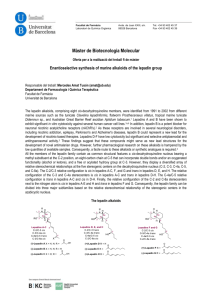Chemistry Standards - Garrett Academy Of Technology
advertisement
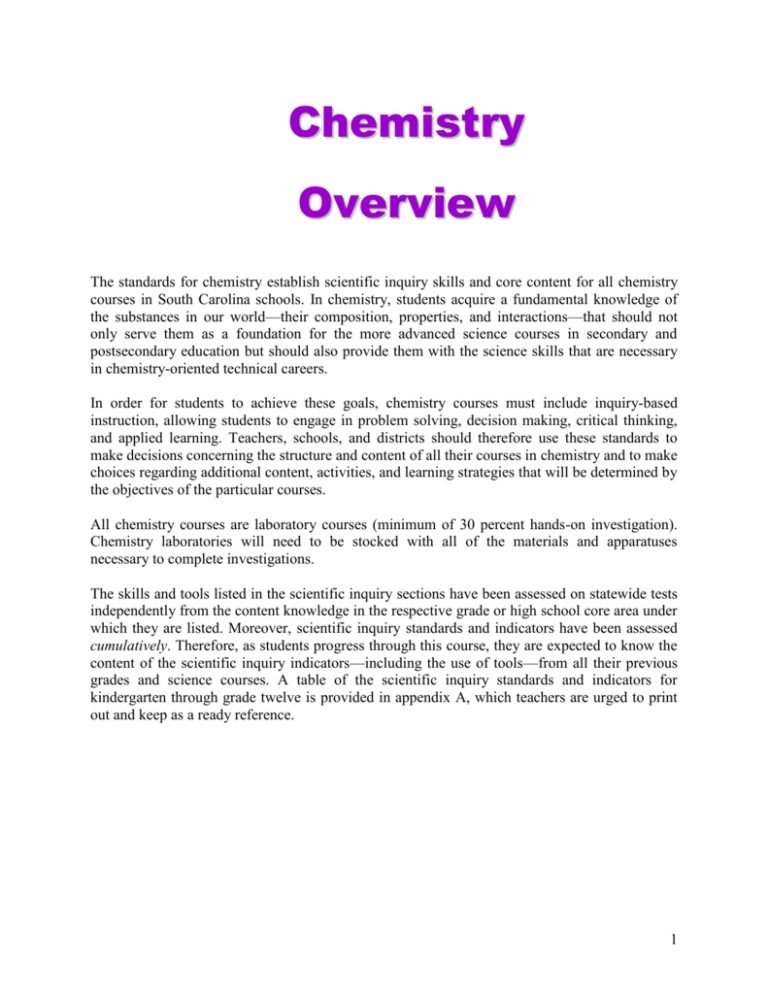
Chemistry Overview The standards for chemistry establish scientific inquiry skills and core content for all chemistry courses in South Carolina schools. In chemistry, students acquire a fundamental knowledge of the substances in our world—their composition, properties, and interactions—that should not only serve them as a foundation for the more advanced science courses in secondary and postsecondary education but should also provide them with the science skills that are necessary in chemistry-oriented technical careers. In order for students to achieve these goals, chemistry courses must include inquiry-based instruction, allowing students to engage in problem solving, decision making, critical thinking, and applied learning. Teachers, schools, and districts should therefore use these standards to make decisions concerning the structure and content of all their courses in chemistry and to make choices regarding additional content, activities, and learning strategies that will be determined by the objectives of the particular courses. All chemistry courses are laboratory courses (minimum of 30 percent hands-on investigation). Chemistry laboratories will need to be stocked with all of the materials and apparatuses necessary to complete investigations. The skills and tools listed in the scientific inquiry sections have been assessed on statewide tests independently from the content knowledge in the respective grade or high school core area under which they are listed. Moreover, scientific inquiry standards and indicators have been assessed cumulatively. Therefore, as students progress through this course, they are expected to know the content of the scientific inquiry indicators—including the use of tools—from all their previous grades and science courses. A table of the scientific inquiry standards and indicators for kindergarten through grade twelve is provided in appendix A, which teachers are urged to print out and keep as a ready reference. 1 CHEMISTRY Scientific Inquiry The skills of scientific inquiry, including a knowledge of the use of tools, will be assessed cumulatively on statewide tests. Students will therefore be responsible for the scientific inquiry indicators from all of their earlier grade levels. A table of the K–12 scientific inquiry standards and indicators is provided in appendix A. Standard C-1: The student will demonstrate an understanding of how scientific inquiry and technological design, including mathematical analysis, can be used appropriately to pose questions, seek answers, and develop solutions. Indicators C-1.1 Apply established rules for significant digits, both in reading a scientific instrument and in calculating a derived quantity from measurement. C-1.2 Use appropriate laboratory apparatuses, technology, and techniques safely and accurately when conducting a scientific investigation. C-1.3 Use scientific instruments to record measurement data in appropriate metric units that reflect the precision and accuracy of each particular instrument. C-1.4 Design a scientific investigation with appropriate methods of control to test a hypothesis (including independent and dependent variables), and evaluate the designs of sample investigations. C-1.5 Organize and interpret the data from a controlled scientific investigation by using mathematics (including formulas, scientific notation, and dimensional analysis), graphs, models, and/or technology. C-1.6 Evaluate the results of a scientific investigation in terms of whether they verify or refute the hypothesis and what the possible sources of error are. C-1.7 Evaluate a technological design or product on the basis of designated criteria. C-1.8 Use appropriate safety procedures when conducting investigations. 2 CHEMISTRY Standard C-2: Students will demonstrate an understanding of atomic structure and nuclear processes. Indicators C-2.1 Illustrate electron configurations by using orbital notation for representative elements. C-2.2 Summarize atomic properties (including electron configuration, ionization energy, electron affinity, atomic size, and ionic size). C-2.3 Summarize the periodic table’s property trends (including electron configuration, ionization energy, electron affinity, atomic size, ionic size, and reactivity). C-2.4 Compare the nuclear reactions of fission and fusion to chemical reactions (including the parts of the atom involved and the relative amounts of energy released). C-2.5 Compare alpha, beta, and gamma radiation in terms of mass, charge, penetrating power, and the release of these particles from the nucleus. C-2.6 Explain the concept of half-life, its use in determining the age of materials, and its significance to nuclear waste disposal. The following indicators should be selected as appropriate to a particular course for additional content and depth: C-2.7 Apply the predictable rate of nuclear decay (half-life) to determine the age of materials. C-2.8 Analyze a decay series chart to determine the products of successive nuclear reactions and write nuclear equations for disintegration of specified nuclides. C-2.9 Use the equation E = mc2 to determine the amount of energy released during nuclear reactions. 3 CHEMISTRY Standard C-3: The student will demonstrate an understanding of the structures and classifications of chemical compounds. Indicators C-3.1 Predict the type of bonding (ionic or covalent) and the shape of simple compounds by using Lewis dot structures and oxidation numbers. C-3.2 Interpret the names and formulas for ionic and covalent compounds. C-3.3 Explain how the types of intermolecular forces present in a compound affect the physical properties of compounds (including polarity and molecular shape). C-3.4 Explain the unique bonding characteristics of carbon that have resulted in the formation of a large variety of organic structures. C-3.5 Illustrate the structural formulas and names of simple hydrocarbons (including alkanes and their isomers and benzene rings). The following indicators should be selected as appropriate to a particular course for additional content and depth: C-3.6 C-3.7 C-3.8 C-3.9 C-3.10 Identify the basic structure of common polymers (including proteins, nucleic acids, plastics, and starches). Classify organic compounds in terms of their functional group. Explain the effect of electronegativity and ionization energy on the type of bonding in a molecule. Classify polymerization reactions as addition or condensation. Classify organic reactions as addition, elimination, or condensation. 4 CHEMISTRY Standard C-4: The student will demonstrate an understanding of the types, the causes, and the effects of chemical reactions. Indicators C-4.1 Analyze and balance equations for simple synthesis, decomposition, single replacement, double replacement, and combustion reactions. C-4.2 Predict the products of acid-base neutralization and combustion reactions. C-4.3 Analyze the energy changes (endothermic or exothermic) associated with chemical reactions. C-4.4 Apply the concept of moles to determine the number of particles of a substance in a chemical reaction, the percent composition of a representative compound, the mass proportions, and the mole-mass relationships. C-4.5 Predict the percent yield, the mass of excess, and the limiting reagent in chemical reactions. C-4.6 Explain the role of activation energy and the effects of temperature, particle size, stirring, concentration, and catalysts in reaction rates. The following indicators should be selected as appropriate to a particular course for additional content and depth: C-4.7 Summarize the oxidation and reduction processes (including oxidizing and reducing agents). C-4.8 Illustrate the uses of electrochemistry (including electrolytic cells, voltaic cells, and the production of metals from ore by electrolysis). C-4.9 Summarize the concept of chemical equilibrium and Le Châtelier’s principle. C-4.10 Explain the role of collision frequency, the energy of collisions, and the orientation of molecules in reaction rates. 5 CHEMISTRY Standard C-5: The student will demonstrate an understanding of the structure and behavior of the different phases of matter. Indicators C-5.1 Explain the effects of the intermolecular forces on the different phases of matter. C-5.2 Explain the behaviors of gas; the relationship among pressure, volume, and temperature; and the significance of the Kelvin (absolute temperature) scale, using the kinetic-molecular theory as a model. C-5.3 Apply the gas laws to problems concerning changes in pressure, volume, or temperature (including Charles’s law, Boyle’s law, and the combined gas law). C-5.4 Illustrate and interpret heating and cooling curves (including how boiling and melting points can be identified and how boiling points vary with changes in pressure). The following indicators should be selected as appropriate to a particular course for additional content and depth: C-5.5 Analyze the energy changes involved in calorimetry by using the law of conservation of energy as it applies to temperature, heat, and phase changes (including the use of the formulas q = mcΔT [temperature change] and q = mLv and q = mLf [phase change] to solve calorimetry problems). C-5.6 Use density to determine the mass, volume, or number of particles of a gas in a chemical reaction. C-5.7 Apply the ideal gas law (pV = nRT) to solve problems. C-5.8 Analyze a product for purity by following the appropriate assay procedures. C-5.9 Analyze a chemical process to account for the weight of all reagents and solvents by following the appropriate material balance procedures. 6 CHEMISTRY Standard C-6: The student will demonstrate an understanding of the nature and properties of various types of chemical solutions. Indicators C-6.1 Summarize the process by which solutes dissolve in solvents, the dynamic equilibrium that occurs in saturated solutions, and the effects of varying pressure and temperature on solubility. C-6.2 Compare solubility of various substances in different solvents (including polar and nonpolar solvents and organic and inorganic substances). C-6.3 Illustrate the colligative properties of solutions (including freezing point depression and boiling point elevation and their practical uses). C-6.4 Carry out calculations to find the concentration of solutions in terms of molarity and percent weight (mass). C-6.5 Summarize the properties of salts, acids, and bases. C-6.6 Distinguish between strong and weak common acids and bases. C-6.7 Represent common acids and bases by their names and formulas. The following indicators should be selected as appropriate to a particular course for additional content and depth: C-6.8 C-6.9 C-6.10 C-6.11 C-6.12 C-6.13 C-6.14 C-6.15 Use the hydronium or hydroxide ion concentration to determine the pH and pOH of aqueous solutions. Explain how the use of a titration can determine the concentration of acid and base solutions Interpret solubility curves to determine saturation at different temperatures. Use a variety of procedures for separating mixtures (including distillation, crystallization filtration, paper chromatography, and centrifuge). Use solubility rules to write net ionic equations for precipitation reactions in aqueous solution. Use the calculated molality of a solution to calculate the freezing point depression and the boiling point elevation of a solution. Represent neutralization reactions and reactions between common acids and metals by using chemical equations. Analyze the composition of a chemical sample by using gas chromatography. 7
